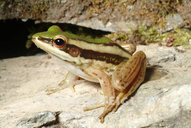|
Hylarana erythraea (Schlegel, 1837)
Green Paddy Frog, Common Green Frog, Leaf Frog | family: Ranidae genus: Hylarana |
 © 2007 Frank Teigler (1 of 29)
|
|
|
|
Description Distribution and Habitat Country distribution from AmphibiaWeb's database: Brunei Darussalam, Cambodia, India, Indonesia, Lao People's Democratic Republic, Malaysia, Myanmar, Philippines, Singapore, Thailand, Viet Nam Malaysian region distribution from AmphibiaWeb's database: Peninsular Malaysia, Sabah, Sarawak
Life History, Abundance, Activity, and Special Behaviors Lifespan in two Philippine populations was reported to be a maximum of 4 years, based on mark-recapture data (Brown and Alcala 1970). Males in these populations attained sexual maturity at about 6-7 months post-metamorphosis, developing nuptial pads at a minimum body size of 34-35 mm SVL, and females attained sexual maturity at about 9 months post-metamorphosis, at a body size of at least 50 mm SVL (Brown and Alcala 1970). Trends and Threats Comments This species, like a number of other ranid species (Berns and Uhler 1966), is normally green-colored but occasionally has blue morphs. Skin chromatophores are responsible for frog coloration and contain three layers: xanthophores, iridophores, and melanophores. Xanthophores contain yellow pigment. Iridophores contain reflecting platelets full of crystalline deposits and scatter light so that shorter (blue) wavelengths are reflected. Melanophores absorb longer wavelengths of light. Since green arises from a combination of blue and yellow, frogs (or body parts) that lack xanthophores appear blue (Bagnara et al. 2007). For more information on the basis of blue coloration in amphibians (both adults and eggs), as well as in other vertebrates, see Bagnara et al. (2007). Other non-ranid amphibians with blue coloration include the blue-spotted salamander, Ambystoma laterale, and a blue poison dart frog that was formerly known as Dendrobates azureus before it was shown to be a variant of the dyeing poison frog Dendrobates tinctorius by Wollenberg et al. (2006). Specimens from India, Nepal, Myanmar and Bangladesh are now assigned to Rana tytleri (Ohler and Mallick 2002).
References
Arak, A. (1984). ''Sex and song in Malaysian frogs and toads.'' Malayan Naturalist, 38, 20-24. Alcala, A. C. (1955). ''Observations on the life history and ecology of Rana erythraea Schlegel, on Negros Island, Philippines.'' Silliman Journal, 2, 175-192. Bagnara, J. T., Fernandez, P. J., and Fujii, R. (2007). ''On the blue coloration of vertebrates.'' Pigment Cell Research, 20, 14-26. Berns, M. W., and Uhler, L. D. (1966). ''Blue frogs of the genus Rana.'' Herpetologica, 22(3), 181-183. Brown, W. C. and Alcala, A. C. (1970). ''Population ecology of the frog Rana erythraea in Southern Negros, Philippines.'' Copeia, 1970, 611-622. Diesmos, A. C., Diesmos, M. L., and Brown, R. (2006). ''Status and distribution of alien invasive frogs in the Philippines.'' Journal of Environmental Science and Management, 9(2), 41-53. Diesmos, A., Alcala, A., Brown, R., Afuang, L., Gee, G., Sukumaran, J., Yaakob, N., Leong Tzi Ming, Yodchaiy Chuaynkern, Kumthorn Thirakhupt, Das, I., Iskandar, D., Mumpuni, Inger, R., Stuebing, R., Yambun, P. and Makl 2004. Hylarana erythraea. In: IUCN 2009. IUCN Red List of Threatened Species. Version 2009.2. www.iucnredlist.org. Downloaded on 25 January 2010. Inger, R. F. and Stuebing, R. B. (2005). A Field Guide to the Frogs of Borneo, 2nd edition. Natural History Publications (Borneo), Kota Kinabalu. Inger, R. F., and Greenberg, B. (1963). ''The annual reproductive pattern of the frog Rana erythraea in Sarawak.'' Physiological Zoology, 36, 21-33. Iskandar, D. T. (1998). The Amphibians of Java and Bali. Research and Development Centre for Biology-LIPI, Bogor, Indonesia. Ohler, A., Mallick, P. K. (2002). ''Rana (Hylarana) sensu Dubois (1992) in India and the identity of Hylarana tytleri Theobald, 1868.'' Hamadryad, 27, 57-65. Wollenberg, K. C., Veith, M., Noonan, B. P., and Lotters, S. (2006). ''Polymorphism versus species richness—systematics of large Dendrobates from the Eastern Guiana Shield (Amphibia: Dendrobatidae).'' Copeia, 2006(4), 623-629. Originally submitted by: Rupi Mudan (first posted 2005-11-18) Edited by: Kellie Whittaker (2014-10-29) Species Account Citation: AmphibiaWeb 2014 Hylarana erythraea: Green Paddy Frog <https://amphibiaweb.org/species/5028> University of California, Berkeley, CA, USA. Accessed Jan 5, 2025.
Feedback or comments about this page.
Citation: AmphibiaWeb. 2025. <https://amphibiaweb.org> University of California, Berkeley, CA, USA. Accessed 5 Jan 2025. AmphibiaWeb's policy on data use. |





 Map of Life
Map of Life